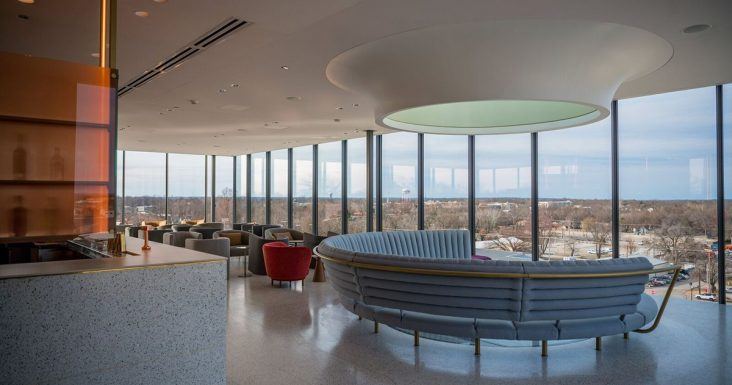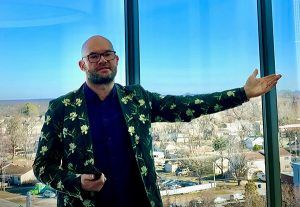The Momentary aims to be a living room for visual arts
by February 21, 2020 3:39 pm 5,094 views

The Tower Bar at The Momentary in Bentonville. Photo by Stephen Ironside, courtesy of The Momentary.
It took roughly six years of planning and undisclosed millions to breathe life into the former Kraft Cheese plant a few blocks from the downtown Bentonville square. The Momentary is a juxtaposition of industrial strength and functionality with the creativity and fluidity of the visual and performing arts.
Olivia Walton, founding chairwoman for The Momentary, said during a media tour of the facility Friday (Feb. 21) the 63,000-square-foot space was designed to be a gritty, contemporary art experience. She said it’s the rebellious little sister of Crystal Bridges Museum of American Art, which was born out of founder Alice Walton’s love for art and desire to make it accessible for all.
Olivia, her husband Tom and brother-in-law Steuart Walton, envisioned a space that would be an extension of Crystal Bridges and provide living and working artists the opportunity to create and perform year-round at the expansive venue.
“By witnessing how Crystal Bridges became an arts destination, bringing tourism and new audiences, new ideas and new perspectives to Bentonville, it was clear that there was more room to expand access to the arts in Northwest Arkansas,” Walton said Friday. “The Momentary will allow people across the community, and from across the country, to engage in cultural experiences together, in a space that welcomes all to come and try something new.”
The Momentary opens to the public Saturday. The 02-22-20 opening date was a goal the founders set two years ago when construction work began.
Part of the challenge of the project lay in its structure, an abandoned Kraft Cheese plant that Tom and Steuart Walton purchased for $1.45 million in May 2014. The initial funding for the transformation was made possible with a multimillion-dollar grant from the Walton Family Foundation. In July 2016, Tom Walton told Talk Business & Politics his vision for the venue was to be a broader outlet that would inspire the next generation of arts and art patrons.
“Our family is committed to giving back to the place where we grew up,” he said. “Surrounded by urban trails and new culinary offerings, this experimental concept will complement our work in Northwest Arkansas – raising the quality of life for all residents, especially the millennial generation.”

Lieven Bertels, who is the director of The Momentary, said the biggest challenge in opening the venue was trying to embrace the original structure and transform it into a contemporary site for the living arts. Bertels moved to Bentonville three years ago from Belgium and said the name “The Momentary” came about from a brainstorming session led by the architects from Chicago-based Wheeler Kerns, whose adaptive reuse design sought to preserve the integrity of the cheese factory and add new elements to support the new purpose of the space.
Bertels said the venue was first named “The Plant” but later changed to reflect being in the moment and those moments of time where one can be transposed through visual and performing arts.
“We were intentional to listen to what the ordinal structure had to say and then worked to embellish and repurpose areas to support the purpose,” he said.
Patrons will see the original milk pressurization tanks, overhead pipes, exposed brick, concrete and metal throughout the industrial space. The galleries for visual arts are inviting and allow living artists large areas to work and display exhibits. The opening exhibit is State of the Art 2020, which runs through May 24. This exhibit spotlights the works of 61 artists from the U.S. and is a continuation of the contemporary art that began in 2014 when Crystal Bridges presented its “State of the Art: Discovering American Art Now” exhibit.
Lauren Haynes, curator of visual arts at The Momentary, said the museum has traveled the country to find living artists and have them create art for the exhibit. She said more than 100 works are part of the exhibit and most have created within the past three years, several being done specifically for The Momentary.
Haynes said the artists will visit the museum at various times during this run to demonstrate their exhibits. There are three art studios where traveling artists can contract to work on projects from 8 weeks to three months at a time at The Momentary. This will begin in April.
Pia Agrawal, the curator for the performing arts at the venue, said the RØDE House is a large performing arts space inside the facility that allows for 600 standing and near 400 sitting with a stage that can face the outdoors through a massive glass wall or the expansive area inside the building. Blackout curtains can be drawn over the glass windows to allow for video viewing.
The RØDE House, so named after one of the venue’s founding funders, Australian-based RØDE Microphones, was the original intake room for the cheese factory and is quite large. There is a bar area adjacent to this performing arts site. Other performing arts galleries onsite include the Fermentation Hall, where a small group of performing artists from the West Coast are directing the programing during the opening weekend.
The Tower Bar space on the seventh floor overlooks the five-acre site with 360-degree views across the city, as well as a large skylight and glass floor that add dimension to the space. The bar is open to members during the day and opens to the public from 5 p.m. to midnight. It offers a full-service bar and furniture for conversation and lounging. The Tower Bar also provides musical entertainment from local and visiting artists.
The Momentary also features the Breakroom, a large co-working space for meeting and conversation with a culinary component. The Breakroom allows patrons to work among the art. Outside the courtyard area there is concrete seating made through 3-D printing. There is also Momentary Green, a spacious outdoor area ideal for picnics and social gatherings.
While Bertels declined to give financial specifics, he said The Momentary employs 44 full-time workers with almost two dozen part-time workers. The museum also has a number of volunteers who are cross-trained with the Crystal Bridges team so they can float between the two facilities.
When asked what the impact The Momentary would have on the community, Bertels said the region is already a destination for world-class art with Crystal Bridges. Now there is another layer that will support living artists and teachers of art. He said the mission for The Momentary is to engage the public with contemporary art year-round, some local as well as globally.
Admission to The Momentary is free thanks to a grant from the Walmart Foundation, but memberships are available for patrons who want to lend support. Bertels said The Momentary’s budget is part of the Crystal Bridges overall operations and run by that foundation. He said ongoing support for The Momentary will come from founding sponsors, memberships, gifts and grants from the public.
Founding funders for The Momentary are the Walmart Family Foundation, Walmart, Rode Microphones, The Coca Cola Co. and Tyson Family Foundation. Other funding sponsors for the State of the State 2020 exhibit include Bank of America, Willard and Pat Walker Charitable Foundation, Christie’s, Coca-Cola, Stella Boyle Smith Trust, Trott Family Foundation, Alturas Foundation, Bracken Darrel and Fred and Shelby Gans.
The Momentary also pays homage to Osage, Quapaw and Caddo people by using the arrow pattern throughout the facility and the logo. The arrow pattern is featured on the ceiling in the main entry space as well as the exterior glass of The Tower.
Museum officials said connecting with the Native American tribes of the region is a critical element of the past and future. Bertels said the arrow patterns do a great job representing the future while also remembering the past.
“The Momentary is a place where the community and visitors alike can share one-of-a-kind experiences while celebrating visual and performing arts in Bentonville, that just happens to be located equal distances from the east and west,” Bertels said.
